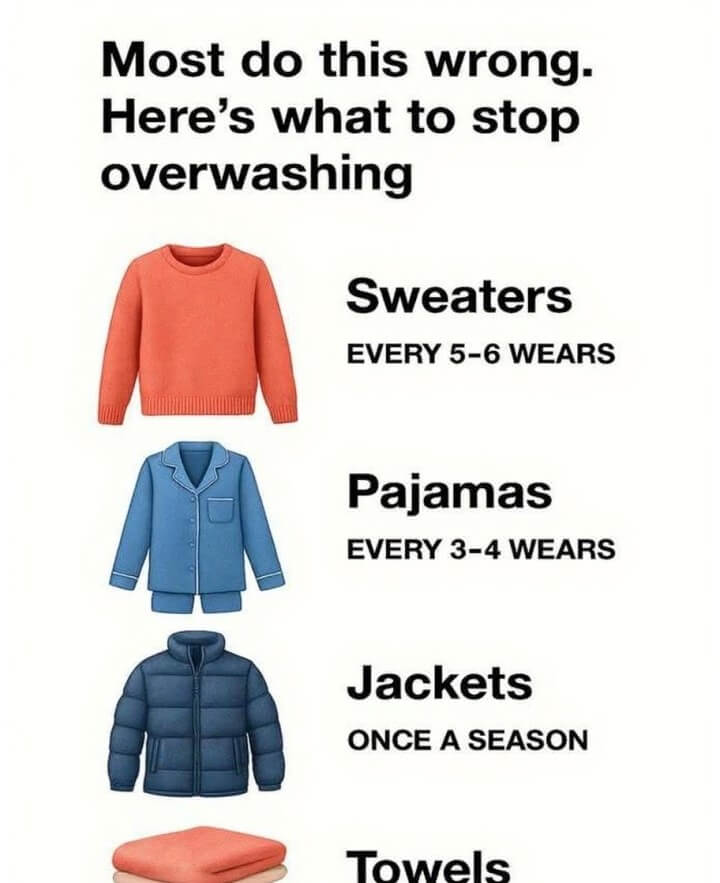In today’s world, we’re constantly told that spotless clothes equal good hygiene. Because of that, many people toss their outfits into the washer after just one wear, assuming it’s the “clean” thing to do. But overwashing can actually shorten the life of your clothing, drain your wallet, and take a toll on the environment. Learning when to wash—and when not to—can help your wardrobe last longer, keep more money in your pocket, and still leave you feeling fresh and confident. Finding that sweet spot between cleanliness and conservation isn’t complicated, and once you understand the basics, it becomes second nature.
1. The Overwashing Epidemic: What Most People Get Wrong
A lot of us don’t realize just how often we wash our clothes. Americans average around 300 loads of laundry a year—about six loads every week. This habit usually comes from the belief that clothes are automatically dirty after one wear, but most garments simply don’t pick up that much bacteria or grime. Excessive washing fades colors, weakens fabric, and wastes huge amounts of water and energy. Rethinking our laundry routines can protect both our clothes and the planet.
2. Understanding Fabric Needs: Why Not All Clothes Are Equal
Different fabrics react differently to frequent washing. Materials like cashmere and silk are delicate and can easily be damaged by constant agitation or harsh detergents, while sturdier fabrics such as cotton or polyester can handle more frequent cycles. Still, even durable clothes rarely need washing after every wear. Reading care labels and understanding fabric needs help you keep each item looking its best for longer.
3. The Science of Sweaters: Why Every 5–6 Wears Is Enough
Wool and cashmere sweaters don’t absorb odors the same way other materials do, which is why they can be worn several times before washing. These fabrics stay fresher naturally and maintain their shape better when washed sparingly. Airing sweaters out between wears and spot-cleaning small stains can keep them looking new without subjecting them to unnecessary washing.
4. Pajamas and Hygiene: Finding the Balance with Every 3–4 Wears
While pajamas should be kept reasonably clean for the sake of comfort and hygiene, washing them every single night isn’t necessary for most people. Wearing them for three to four nights is usually ideal unless you sweat heavily or have specific health needs. This simple shift can lighten your laundry load and help your favorite sleepwear last longer.
5. Seasonal Care for Jackets: Once a Season Is All You Need
Outerwear, especially coats and jackets made from wool or heavy-duty materials, rarely needs frequent washing. Since they don’t sit directly against your skin, once-a-season cleaning is usually enough. Regularly airing them out or spot-cleaning small marks helps keep them fresh while protecting the fabric from unnecessary stress.
6. Towel Talk: The 3-Use Rule for Optimal Freshness
Towels get washed too much in most homes, even though they’re only touching clean skin. Washing them every three uses is a smart balance between cleanliness and practicality. Letting them dry fully between uses prevents mildew and keeps them smelling fresh. Hanging them properly can make a noticeable difference in how long they stay clean.
7. Environmental Impact: How Overwashing Hurts the Planet
Every load of laundry uses around 40 gallons of water, along with energy for heating and machine operation. That adds up quickly. Reducing wash frequency shrinks your environmental footprint by lowering water use, cutting energy consumption, and reducing the amount of detergent released into the ecosystem. The change may seem small, but the collective impact is enormous.
8. Saving Money and Time: The Hidden Costs of Overwashing
Laundry doesn’t just cost time—it costs money. Between water, electricity, detergent, and faster wear on clothing, overwashing becomes surprisingly expensive. Washing less often means fewer utility bills, fewer clothing replacements, and more hours back in your week. It’s a simple shift with major financial benefits.
9. Viral Hacks and Myths: Debunking Popular Laundry Advice
The internet is packed with laundry hacks, but not all of them hold up. Using extra detergent doesn’t make clothes cleaner and can actually leave a residue that irritates skin. Hot water isn’t a cure-all either—while helpful for very dirty items, it can shrink or fade many fabrics. Being selective about which tips you follow helps you avoid accidental damage.
10. How to Develop a Personalized Laundry Schedule
A great laundry routine starts with understanding your wardrobe. Think about how often you wear each piece, the activities you do in them, and the fabric they’re made of. Activewear might need washing after each use, while jeans often last four to five wears before they need cleaning. Build a schedule that suits your lifestyle, and don’t be afraid to make adjustments along the way.
11. Expert Tips for Extending the Life of Your Clothes
A few simple habits can dramatically extend the life of your wardrobe. Always follow care labels, and choose gentle wash cycles when possible. Turning clothes inside out reduces fading, and air drying keeps fabrics from shrinking or wearing out too quickly. Using a mild detergent and avoiding overloaded wash cycles helps clothes come out cleaner and last longer. With a little extra care, your clothes can stay looking new season after season.
